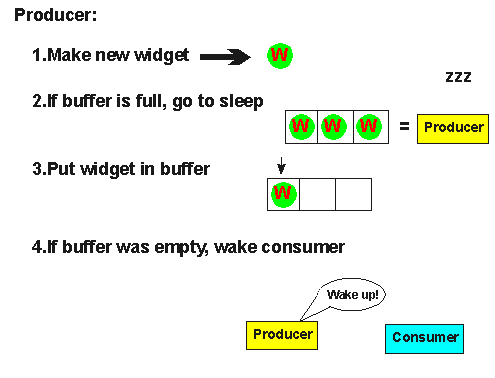Overview
Producer-consumer problem illustrates the need for synchronization in systems where many processes share a resource.
In the problem, two processes share a fixed-size buffer. One process produces information and puts it in the buffer, while the other process consumes information from the buffer. These processes do not take turns accessing the buffer, they both work concurrently.
Inadequate Solution


The code might look like this:
BufferSize = 3;
count = 0;
Producer()
{
int widget;
WHILE (true) { // loop forever
make_new(widget); // create a new widget to put in the buffer
IF(count==BufferSize)
Sleep(); // if the buffer is full, sleep
put_item(widget); // put the item in the buffer
count = count + 1; // increment count of items
IF (count==1)
Wakeup(Consumer); // if the buffer was previously empty, wake
} // the consumer
}
Consumer()
{
int widget;
WHILE(true) { // loop forever
IF(count==0)
Sleep(); // if the buffer is empty, sleep
remove_item(widget); // take an item from the buffer
count = count + 1; // decrement count of items
IF(count==N-1)
Wakeup(Producer); // if buffer was previously full, wake
// the producer
Consume_item(widget); // consume the item
}
}
This will cause problems, because it contains a race condition that can lead to a deadlock. Or in simply words, it has the potential of losing wakeups.
An alternative analysis is that if the programming language does not define the semantics of concurrent accesses to shared variables (in this case itemCount) without use of synchronization, then the solution is unsatisfactory for that reason, without needing to explicitly demonstrate a race condition.
Solutions are: semaphores or monitors.
Semaphore
semaphore mutex = 1;
semaphore fillCount = 0;
semaphore emptyCount = BUFFER_SIZE;
procedure producer() {
while (true) {
item = produceItem();
down(emptyCount);
down(mutex);
putItemIntoBuffer(item);
up(mutex);
up(fillCount);
}
}
procedure consumer() {
while (true) {
down(fillCount);
down(mutex);
item = removeItemFromBuffer();
up(mutex);
up(emptyCount);
consumeItem(item);
}
}
Monitor
monitor ProducerConsumer {
int itemCount;
condition full;
condition empty;
procedure add(item) {
while (itemCount == BUFFER_SIZE) {
wait(full);
}
putItemIntoBuffer(item);
itemCount = itemCount + 1;
if (itemCount == BUFFER_SIZE -1) {
notify(full);
}
}
procedure remove() {
while (itemCount == 0) {
wait(empty);
}
item = removeItemFromBuffer();
itemCount = itemCount - 1;
if (itemCount == 1) {
notify(empty);
}
return item;
}
}
procedure producer() {
while (true) {
item = produceItem();
ProducerConsumer.add(item);
}
}
procedure consumer() {
while (true) {
item = ProducerConsumer.remove();
consumeItem(item);
}
}